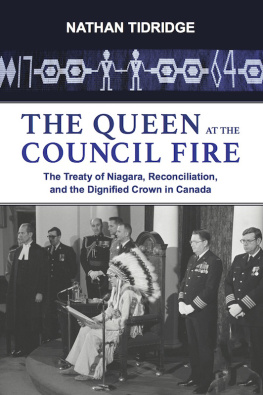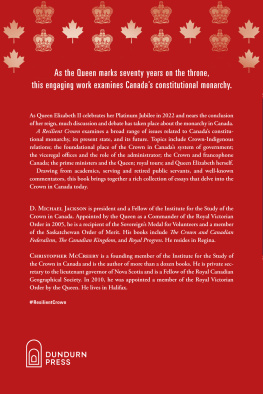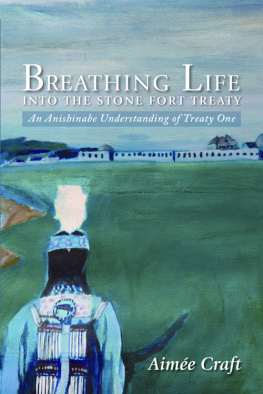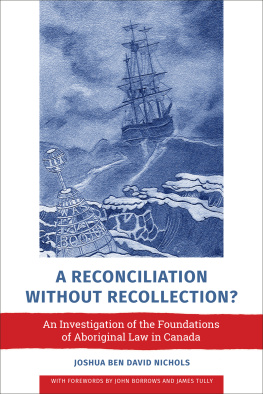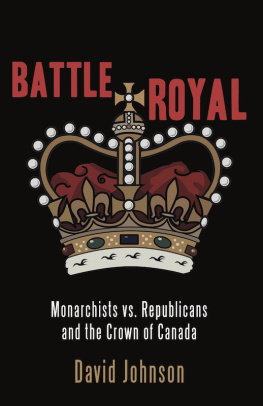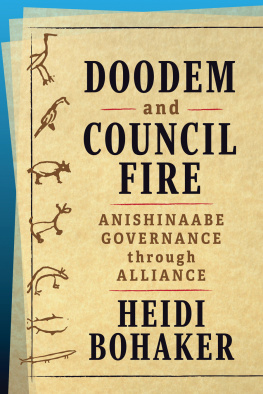Endorsements for The Queen at the Council Fire
This is a beautiful, clear, and well-written book. Thanks to Nathan Tidridge for producing a great piece of scholarship, research, and good feeling. I definitely recommend this book.
Professor John Borrows, Canada Research Chair in Indigenous Law
It is my privilege as a lieutenant governor of Ontario who was deeply involved in Aboriginal matters during my term to strongly recommend Nathan Tidridges latest book, The Queen at the Council Fire . It is a must-read for anyone wanting to understand the history of the relationship between the Crown and Indigenous peoples and why that relationship is crucial to Canadas future relations with First Nations.
Honourable David C. Onley, O.Ont., 28th Lieutenant Governor of Ontario
With The Queen at the Council Fire, Nathan Tidridge has gifted us a concise, sharp, and detailed account of one of the most important events in Canadas history, a moment all too often ignored in the history books.
Niigaanwewidam James Sinclair, Associate Professor, Department of Native Studies, University of Manitoba
Constitutional monarchy is usually discussed in terms of principles . This account demonstrates that when the subject is First Nations, it is the practices of the Crown in its long relationship with Indigenous peoples that are of paramount concern. Through the prism of the Crown, Nathan Tidridge offers a unique perspective on a subject of fundamental importance.
Dr. David Smith, Author of The Invisible Crown: The First Principle of Canadian Government
Nathan Tidridge has given us a richly textured account of the historic meeting of First Nations with Sir William Johnson, the British Monarchs personal representative, at Niagara in 1764. The Treaty of Niagara is Canadas first Confederation. Tidridges book is must reading for understanding Canadas constitutional foundations.
Dr. Peter Russell, Professor Emeritus of Political Science at the University of Toronto
The Covenant Chain is a metaphor for alliance between the Crown and various Indigenous nations. This metaphor is represented on wampum belts by two men holding hands or two men holding a chain, bound together by the silver chain of friendship. In old councils, both participants of the treaty had to re-tell the talk on the belt to demonstrate their understanding of the mutual obligations. Long ago, the representatives of the Crown had let go their end of the belt and had quit coming to the council fire to polish the chain. In this book, Mr. Tidridge offers a re-telling of the talk from a modern-day Canadian perspective.
Alan Corbiere, Anishinaabe Cultural Historian, MChigeeng First Nation
In The Queen at the Council Fire , Nathan Tidridge demonstrates the link between Canadian federalism and the First Nations, debunking the assumption that Indians are simply an issue for Ottawa. Mr. Tidridge encourages us to look beyond the stereotypes and appreciate the mutual interest of both orders of government in collaborating with the First Nations through the unique institution of the Canadian Crown.
D. Michael Jackson, CVO, SOM, CD, Author of The Crown and Canadian Federalism (Dundurn, 2013), Vice-President, Institute for the Study of the Crown in Canada
Nathan Tidridge offers a thoughtful and rich interpretation of the Treaty of Niagara, highlighting the Covenant Chain and its direct relationship with Indigenous peoples. The Queen at the Council Fire is an important read for educators and the greater community to help facilitate respectful and meaningful conversations about mutual obligations, relationship building, and aspects of reconciliation.
Dr. Jenny Kay Dupuis, Member of the Nipissing First Nation
Nathan draws the reader into an important story about a little known and often complex subject. Nya:weh Nathan for all of your hard work, passion, and friendship.
Heather George, Acting Cultural Coordinator of Her Majestys Royal Chapel of the Mohawks, Cultural Coordinator of Chiefswood National Historic Site


Dedication
Dedicated to my wife, Christine Vanderwal. A passionate educator, Christine is actively engaged in fostering reconciliation, helping the Canada she loves reach its full potential. I explore these waters together with her.
Table of Contents
Acknowledgements
T his book began as an essay written to highlight the importance of the Treaty of Niagara and its relationship to the offices of the Canadian Crown. This journey has brought me into contact with many people, including great teachers, knowledge keepers, elders, and good friends. All of them have helped develop my respect of the Covenant Chain and the treaty that extended it into these lands.
Here I acknowledge and thank Dr. John Borrows (Canada Research Chair in Indigenous Law at the University of Victoria Law School), Mr. Nick Bridges (University of Ottawa), Mr. Alan Corbiere (Anishinaabe Cultural Historian, MChigeeng First Nation), Mr. Richard Berthelsen (Managing Director, Institute for the Study of the Crown in Canada at Massey College), Dr. Jenny Dupuis (Member of the Nipissing First Nation), Mr. Dominic Farrell (my extraordinary editor with Dundurn Press), Ms. Heather George (Cultural Coordinator, Chiefswood National Historic Site and Her Majestys Royal Chapel of the Mohawks), Ms. Jane Gibson (Natural History/Natural Heritage Inc.), Mr. James Hammond (Private Secretary) and the Office of the Lieutenant Governor of British Columbia, Mr. Rick Hill (The Six Nations Legacy Consortium), Mr. Kirk Howard (Founder and President of Dundurn Press), Mr. Anthony Hylton (Private Secretary) and the Office of the Lieutenant Governor of Ontario (particularly Mr. Eugene Berezovsky and Mr. John Gross), Mr. Sean Kearney (McMaster University), Ms. Carolyn King (Mississaugas of the New Credit First Nation), Dr. Philippe Lagass (Associate Professor of Public and International Affairs, University of Ottawa), Mr. Ken Maracle (Faith Keeper of the Lower Cayuga Longhouse, Member of the Cayuga Nation), Dr. Christopher McCreery (Private Secretary) and the Office of the Lieutenant Governor of Nova Scotia, the Honourable David C. Onley (Twenty-Eighth Lieutenant Governor of Ontario), Mrs. Ruth Ann Onley, Mr. Barry Penhale (Publisher Emeritus, Dundurn Press), the Honourable Steven L. Point (Twenty-Eighth Lieutenant Governor of British Columbia), Cheryl Red Eagle and the Staff at the Woodland Cultural Centre, Dr. Peter Russell (Professor Emeritus of Political Science at the University of Toronto), Ms. Heather Salloum (Private Secretary and Executive Director) and the Office of the Lieutenant Governor of Saskatchewan, Elder Garry Sault (Mississaugas of the New Credit First Nation), Dr. David Smith (Distinguished Visiting Professor in the Department of Politics and Public Administration and a Member of the Yeates School of Graduate Studies at Ryerson University), Professor Thomas H.B. Symons (Vanier Professor Emeritus and Founding President of Trent University), and Ms. Barb Walline (Private Secretary) and the Office of the Lieutenant Governor of Alberta.
I am honoured that The Queen at the Council Fire launches The Institute for the Study of the Crown in Canada (ISCC) at Massey College , a series of books being developed through a partnership between Dundurn Press and the Institute for the Study of the Crown in Canada at Massey College. This collection recognizes the tremendous contributions made by Kirk Howard in educating Canadians about their constitutional monarchy. Kirk is a remarkable man, and his decades of work in preserving Canadian history, identity, and culture will have lasting effects for generations to come.




